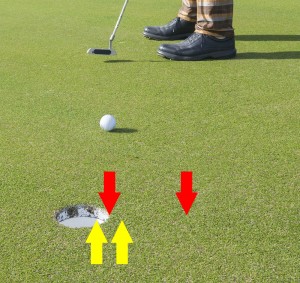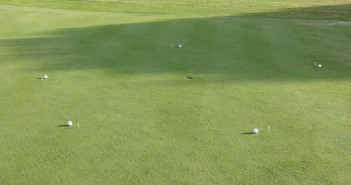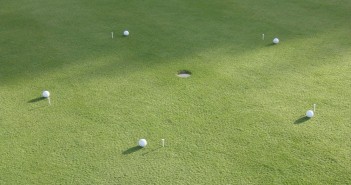You’ve heard it a thousand times, “keep the ball below the hole with your approach shots into the putting green”. Every time you watch golf on TV, you hear the pundits describing how a shot was well played because it finished beneath the hole, that the golfer left themselves an uphill putt.
You know from experience that an uphill putt is easier, and that downhill putts can be seriously scary. Yet most amateur golfers don’t fully understand why erring on the low side is so important, and what a huge difference it can make to their scores.
The increased difficulty of putting from above the hole comes not just from the increased amount of break, that part is obvious, but from the variability of the break based on putt length and green speed, and thus on the myriad of factors that determine green speed. These putts are exponentially harder to read, and much more susceptible to the unknowable variables on any given green.
To help you appreciate why it makes such a difference to your chances of sinking the putt, take a look at the three images below:
Each image shows the lines of 4 different putts on an average slope (2% incline, left to right). The putt lines assume you want to hit the centre of the cup with a putt played at the pace required to take it 12″ past the hole.
Putts played from directly below the hole would obviously be straight. The yellow arrows show the lines for putts played from 30° away from directly below the hole – so if the hole was a clock face with 6 o’clock being directly below the hole, these putts are played from 7 o’clock in the images above. The red arrows show the lines if the putts were played from pin high – 9 o’clock.
For each direction, putt lines are shown for 3′ and 10′ putts – the corresponding arrow nearest the hole is the line for a 3′ putt.
Figure 1 shows the lines for an average green speed (8 on the stimpmeter). Figure 2 shows the lines for a quick 10 stimp green, and Figure 3 shows the lines for a very fast 12 stimp green.
You can see in Figure 1 (average speed green) that, from below the hole (yellow arrows), the correct read from 3 feet is about 1″ inside the edge of the cup, and for a 10′ putt the line is 1″ outside the cup. So inside about 10′, you could expect to sink a well-paced putt if you aimed for the left edge, hit it a little firmer and you don’t even need to aim outside the cup!
From pin high, a 3′ putt should be aimed at the left edge, and from 10′ the line is 6″ outside the cup. This putt is much more difficult to read. Not only do you have to see a more complex line, but a small difference in putt length will make a big difference to the required line – the difference between making the putt and missing it by a considerable margin.
Now factor in green speed. On a quick green (Figure 2) the line from 10′, pin high, is now 9″ outside the cup, and from 3′ it’s 1″ – that’s 8″ difference in line across a range of putt lengths that, statistically, you really should be hoping to make. Yet from below the hole, the line from 3′ to 10′ ranges from the left edge to 2″ outside left – the line is much the same for a wide range of putt lengths, and very close to the correct line on a much slower green, and hence so much easier to read.
And on a very fast green (Figure 3), the pin high line from 3′ to 10′ varies by a full 11″.
When we consider that green speed isn’t a known or fixed quantity – it varies from green to green, depending on the time of day, temperature, humidity, wind, grain, surface quality, spike marks, pitch marks, footprints, detritus, insects and burrowing creatures, topology and so on – we can see that reading the green from pin high just cannot be an exact science, there are too many variables determining a wide range of possible lines, and many of those variables have unknowable quantities. And as we move above the hole things just get worse, not only is the break further increased, but the putt is far more dependent on pace, and so on the vagaries of the green surface and playing conditions.
Yet from below the hole all of these variables can only make a small difference to the ideal line of the putt – what makes all the difference from pin high may be negligible for an up hill putt.
Even small errors in the line that you start an up hill putt are nowhere near as likely to cause you to miss it. If you pull an up hill putt by one degree, it might still hit the left side of the cup and go in. From pin high the same error might make you miss the putt by a foot or more! This variability and sensitivity to error increases the pressure you feel, introduces tension into your stroke, and so makes such errors more likely!
An up hill putt is just plain simpler… infinitely simpler!
And if we consider a steeper slope, 4% instead of 2%, the variables are magnified 3-fold – on an average green from pin high, the difference in line between 3′ and 10′ putts is 17″, whereas from below the hole the spread of lines is only 4″. Same length putt, more than 4 times the difficulty just in seeing the line, never mind all of the other variables that come into play!
Now, when you see even the world’s best leave themselves a steep downhill putt on a breezy day at the Masters, you might wonder how they keep from breaking down in tears!
Leaving yourself an uphill putt can make an enormous difference to your chances of holing out, probably a far greater difference than you realised. Bear that in mind every time you’re attacking the pin from the fairway, trying to get up and down from around the green, or even playing a lag putt across the green, and your scores will be lower.
Happy fairways!

To quickly improve your scores, check out the Golf Loopy Putt like a Champion series, the sensational new putting game improvement system that will help you to improve every aspect of your performance on the greens. The improvements will be dramatic, and they will be permanent.







